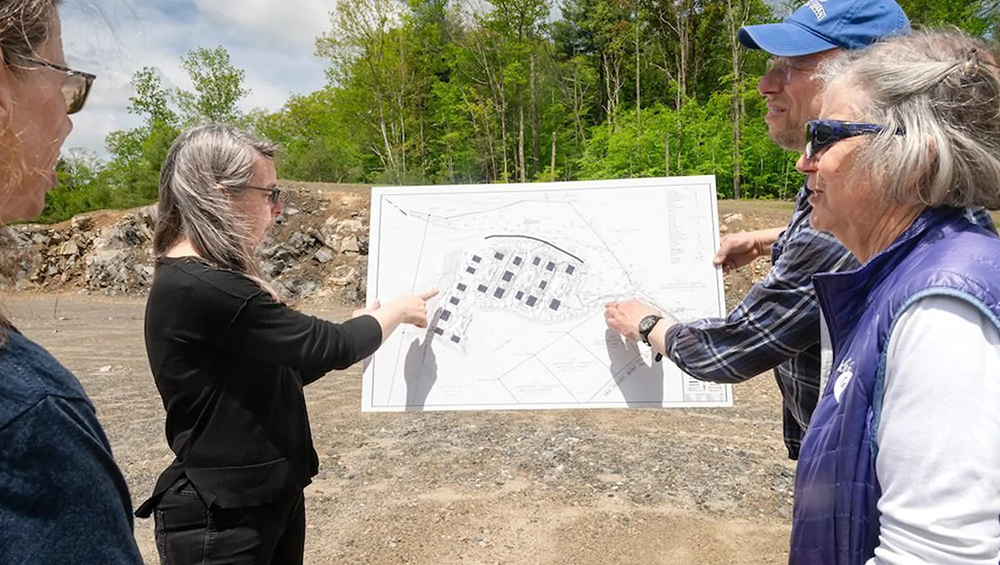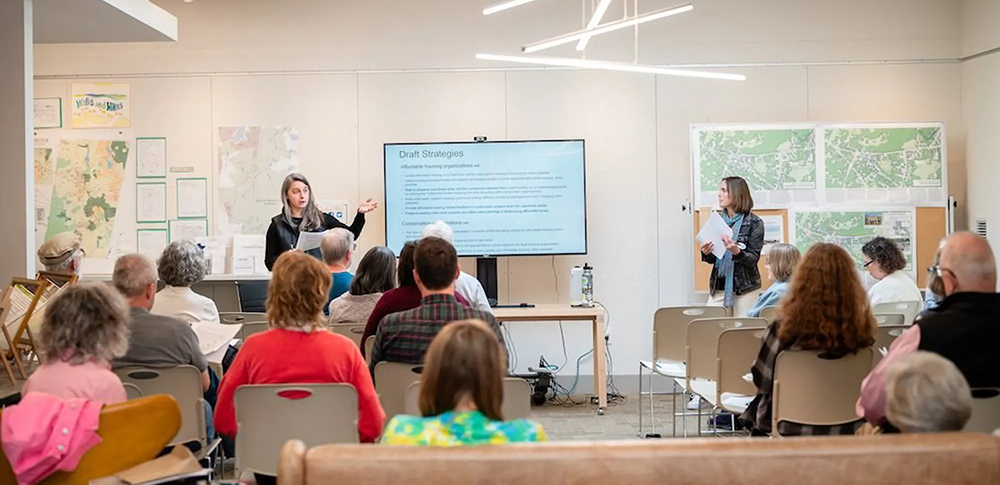Northwestern Connecticut is one of New England’s most iconic landscapes, home to rolling hills, verdant forests, vast wetlands, cold water lakes, meandering rivers, and an abundance of both residential and migratory wildlife. Those seeking a challenge can summit the state’s tallest mountains while fishermen cast their flies for trout and locavores relish the region’s vibrant food scene. For those who love to be surrounded by nature, this is an ideal place to live, work, recreate, and raise a family.

But with soaring housing costs, many people—especially first-time home buyers and those on a restricted income—are being priced out. In Litchfield County, the median home sales price last month was up 9% from a year ago. In Cornwall, Kent, and many other towns, a single-family home can easily cost you upwards of a million dollars.
“There isn’t a lot of diverse housing stock for people that are beginning homeowners, looking to rent, or seniors who are looking for step-down housing,” says Connie Manes, Executive Director of the Kent Land Trust. “There is a predominance of larger, vacation homes, but overall, there’s a lack of housing diversity, and certainly a lack of housing that’s affordable for people who are just starting out.”
It might seem unusual to hear a conservation professional talk about the housing crisis. Indeed, when Manes began her career two decades ago, most land trusts were solely focused on land protection. And conservationists and affordable housing advocates, in specific, often perceived each other’s mission as incompatible with their own.

“Over the years, some people have tried to use conservation organizations to drive home a NIMBY (Not In My Backyard) argument, to say, ‘I don’t want affordable housing because there’s a salamander there, or because that should be a public park,’” she says.
But recently, with the growing climate crisis and the need to conserve enough land to ensure we have clean air, drinkable water, and species resiliency, many land trusts have begun to recognize that in order to be effective, they must develop strong partnerships to leverage funding, community support, and organizational capacity, including with folks outside the conservation field.
“The way that land trusts operate today is very community-based,” Manes says. “Land trusts have a scope of work that is much larger than just land preservation. As non-profit organizations formed to pursue public benefit, we really want to come out front and center with our partners in town that are also looking to serve the community.”
In early 2024, the Litchfield Hills Greenprint Collaborative, a Regional Conservation Partnership (RCP) of more than 30 partners in northwestern Connecticut, and the Litchfield County Center for Housing Opportunity, which supports affordable housing organizations, formed the Northwest Connecticut Affordable Housing and Conservation Collaboration. Their goal was to create a network within local communities to find common ground and opportunities for collaboration in both conservation and affordable housing projects. More than 60 representatives from over 40 organizations joined the collaboration, including members of Boards of Selectmen, Planning and Zoning Commissions, conservation organizations, and housing organizations such as Habitat for Humanity. Over the next several months, they drafted a purpose statement, defined goals, and developed strategies for assisting local communities, including a mapping tool to help towns evaluate parcels suitable for conservation and affordable housing development.
Land trusts have a scope of work that is much larger than just land preservation.
There are ways that we can work together to make this place better.
The group’s purpose statement is simple and straightforward: Healthy communities need both affordable housing and land conservation. But Manes, who serves as co-facilitator of the collaborative on behalf of the Housatonic Valley Association, cautions that not all organizations might be at a point where they’re ready to jump to this kind of vision. While the collaboration brought together organizations who may have been unaccustomed to partnering with each other, many of the individual participants knew each other and had previously worked together. These pre-existing relationships gave the group a head start in building the trust required for collaboration, says Manes.
“I think coming to the truth of the purpose statement would be important for any group trying to replicate this work,” she says. “We talked about our communities; we explored places of alignment in our visions; we thought about many ways we could work together, including by being a voice of support for each other’s projects. And then going forward it’s like, ‘Okay, well what can we do? How can we problem-solve to make both affordable housing and conservation happen in a way that’s beneficial and aligned?’”
Collaborative Conservation
The collaboration, which included the towns of Cornwall, Falls Village, Goshen, Kent, Norfolk, Salisbury, Sharon, and Warren, and was supported by grants from the Berkshire Taconic Community Foundation and Foundation for Community Health, builds on the work of the Greenprint Collaborative, including its participation in Follow the Forest, a large landscape initiative that seeks to conserve a connected corridor of core forest from the Hudson Valley to Canada and encompasses the Greenprint’s region.

“Follow the Forest makes it easy to evaluate whether the property under consideration is core forest habitat; whether development in a certain place would be disrupting habitat in some way, depending on how that land is developed,” Manes says. “(It) informs where the linkages are between core forests, and where we might be cognizant of how wildlife is going to move through a developed area and make better decisions that way.”
“Follow the Forest is a strategic land protection vision to help accomplish the goals and meet the multiple priorities that communities have,” echoes Isabel Bronson, Conservation Projects Coordinator at the Housatonic Valley Association, which oversees the Greenprint Collaborative. “It’s understanding where these ecologically important pieces of land are for climate resilience and where we can support communities in other ways, such as affordable housing
Manes also credits the RCP Network for cultivating a space for people to connect around issues that cross boundaries, both real and perceived. “The RCP Network is really good at opening our minds about how we might work together, who we might work with, how to serve people, and how to live in this world together,” she said. “(It) allows a lot of people who are trying really innovative and terrific things to come together, share information, think about lessons learned, and replicate each other’s projects. It’s beyond safe; it’s a celebratory place to do that.” Manes, who previously served on the RCP Network Steering Committee, believes the RCP model enables more people to participate in their community’s future, including conservation and affordable housing, through collaboration.
“There are ways that we can work together to make this place better,” she says. “There are still things we can talk about; there’s still a place where we can connect. And probably we align, so let’s find that place and work together. That participatory nature is unique to RCPs, to the RCP Network, and to the work we’re doing here.”